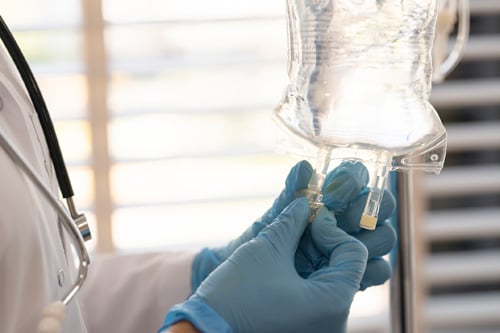Key points
- Primary amebic meningoencephalitis (PAM) caused by Naegleria fowleri is treated with a combination of medications.
- There have been five well-documented survivors of PAM in North America.

Medication options
Recommended treatment for PAM caused by Naegleria fowleri infection
A combination of medications is recommended for treatment of Naegleria fowleri infections. These drugs have been used in PAM survivors. Many have been found to have antiamebic activity against Naegleria fowleri in the laboratory.
| Drug | Dose | Route | Maximum Dose | Duration | Comments |
|---|---|---|---|---|---|
| Amphotericin B* | 1.5 mg/kg/day in 2 divided doses, THEN | IV | 1.5 mg/kg/day | 3 days | |
| 1 mg/kg/day once daily | IV | 11 days | 14-day course | ||
| Amphotericin B | 1.5 mg once daily, THEN | Intrathecal | 1.5 mg/day | 2 days | |
| 1 mg/day every other day | Intrathecal | 8 days | 10-day course | ||
| Azithromycin | 10 mg/kg/day once daily | IV/PO | 500 mg/day | 28 days | |
| Fluconazole | 10 mg/kg/day once daily | IV/PO | 600 mg/day | 28 days | |
| Rifampin | 10 mg/kg/day once daily | IV/PO | 600 mg/day | 28 days | |
| Miltefosine** | Weight<45 kg 50 mg BID Weight>45kg 50 mg TID |
PO | 2.5 mg/kg/day | 28 days | 50 mg tablets |
| Dexamethasone | 0.6 mg/kg/day in 4 divided doses | IV | 0.6 mg/kg/day | 4 days | |
| Nitroxoline*** | Contact CDC for dosing |
*Conventional amphotericin (AMB) is preferred. When AMB was compared with liposomal AMB against Naegleria fowleri, the minimum inhibitory concentration (MIC) for AMB was 0.1 µg/mL, while that of liposomal AMB was 10x higher at 1 µg/ml. Liposomal AMB was found to be less effective in the mouse model and in in vitro testing than the more toxic form of AMB. AMB methyl ester was also found to be less effective in the mouse model. Because the prognosis of Naegleria fowleri infection is extremely poor, consider aggressive treatment.
**The table lists the standard miltefosine dose in adults. A higher dose leads to increased nausea, vomiting, or diarrhea. Miltefosine is mildly nephrotoxic and the dosing may need to be adjusted for patients with impaired kidney function. However, few data are available about the effective dose for amebic infection. The risk of nephrotoxicity should be balanced with the risk for death from PAM. Miltefosine is now commercially available. Please visit impavido.com for more information.
***Nitroxoline is an investigational drug that may be effective for Naegleria fowleri infections. It is not FDA-approved in the United States, but available for treatment of free-living ameba infections through CDC’s expanded access Investigational New Drug program. Contact the CDC Emergency Operations Center at 770-488-7100 for more information.
Survivor medications
Medications given to people who survived PAM
Although most people who get PAM caused by a Naegleria fowleri infection don't survive, there have been five documented cases of survivors in North America.
| U.S. Survivor (1978) |
Mexico Survivor (2003) |
U.S. Female Survivor (2013) |
U.S. Male Survivor (2013) |
U.S. Survivor (2016) |
|---|---|---|---|---|
| Amphotericin B (IV and intrathecal) |
Amphotericin B (IV) |
Amphotericin B (IV and intrathecal) |
Amphotericin B (IV and intrathecal) |
Amphotericin B (IV and intrathecal) |
| Rifampin (oral) |
Rifampin (oral) |
Rifampin (IV/oral) |
Rifampin (oral) |
Rifampin (IV/oral) |
| Miconazole (IV and intrathecal) No longer available in the U.S. |
Fluconazole (IV and oral) |
Fluconazole (IV/oral) |
Fluconazole (IV) |
Fluconazole (IV/oral) |
| Sulfisoxazole (IV) Discontinued after Naegleria fowleri infection diagnosed |
Ceftriaxone (IV) |
Azithromycin (IV/oral) | Azithromycin (IV/oral) |
Azithromycin (IV/oral) |
| Phenytoin | Miltefosine (oral) |
Miltefosine (oral) |
Miltefosine (oral) |
|
| Dexamethasone | Dexamethasone (IV) | Dexamethasone (IV) | Dexamethasone (IV) | Dexamethasone (IV) |
- Successful treatment of primary amebic meningoencephalitis
- Pathogenic and opportunistic free-living amoebae: Acanthamoeba, Balamuthia mandrillaris, Naegleria fowleri, and Sappinia diploidea
- Successful treatment of Naegleria PAM using IV amphotericin B, fluconazole, and rifampin
- Successful treatment of an adolescent with Naegleria fowleri primary amebic meningoencephalitis
- Use of the novel therapeutic agent miltefosine for the treatment of primary amebic meningoencephalitis: report of 1 fatal and 1 surviving case
- Epidemiology and Clinical Characteristics of Primary Amebic Meningoencephalitis Caused by Naegleria fowleri: A Global Review
